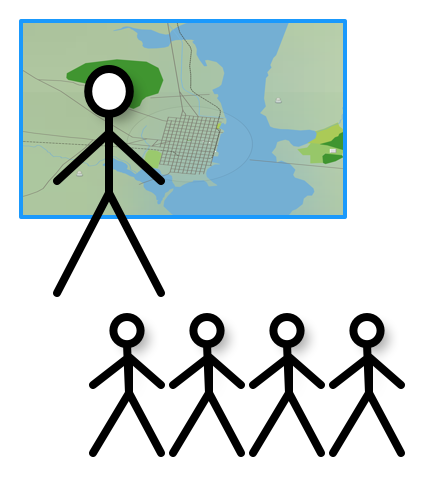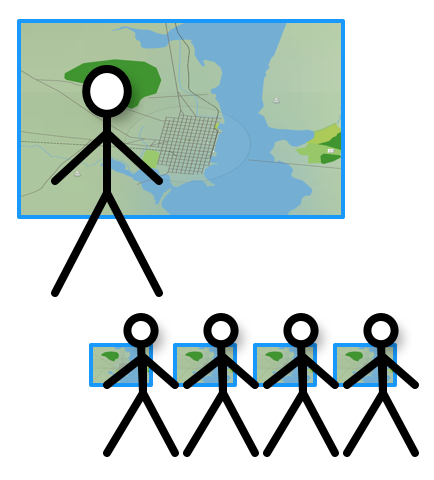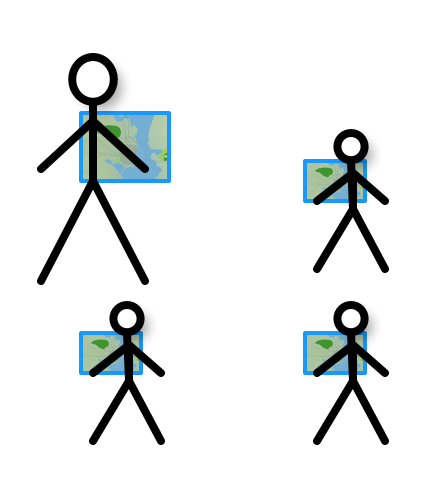Using Lesson Plans
Running Reality lesson plans gives students a fun, interactive way to learn history while giving teachers simple tools to meet learning objectives in a dynamic (possibly remote) classroom.
Overview
Running Reality can be used effectively in a classroom to enhance the existing way history is taught. A Running Reality lesson plan lets you walk your class through a set of predetermined points in time and location, with explanatory text, to accompany your lecture. The lesson can be shown on a display screen, touch panel, or student tablets. To get the most out of a lesson plan, we lay out teaching best practices and practical technical information about sharing and integration. Currently, you can purchase a blank lesson plan template into which you can load the history steps to which you want to teach.
Pedagogy
How do you effectively integrate new kinds of digital history tools, like Running Reality, into your already crowded classroom schedule? Pedagogy is the art, science, or profession of teaching and we closely follow research advances and best practices for teaching digital history and digital humanities. It seems every digital history website has a section on pedagogy because integrating these new kinds of tools with the learning objectives teachers must meet and into the daily life of classrooms is new and complex without much historical precedent.
At a theoretical level, we at Running Reality believe that we can use the power of today's computers and mobile devices to bring history to life in an accessible, immersive, and engaging way for K-12 students, history enthusiasts, and visitors to historical sites. Some students learn very well through traditional narrative history. As a work of historical context, we cannot ever express the level of narrative detail that a work such as a book can. Most historians work in the narrative form and Running Reality doesn't fit this form. Most of the time it has fewer words on the screen than even a historical atlas has on a map page. However, Running Reality has what we call an "emergent visual narrative."
At a practical level, we want to provide simple, clear tools that feel natural for digital natives -- like today's students. Digital tools are now everywhere and they are especially in the lives of students. Further, ubiquitous, powerful computer graphics are making things like ancient battles and cities come to life on movie screens and video game screens. Google Maps has made maps of every spot on Earth available on nearly every device with an Internet connection. These trends are only accelerating. For students, the future of history is digital. The future of digital history is tools that can match the flexibility, accessibility, and convenience that students now expect with rigorous attention to historical accuracy and integration with other tools.
Teachers have learning objectives and new tools and techniques must help meet those objectives to be useful in the classroom. We have provided a list of sample activities paired with standardized skills and learning questions to show how to meet common learning objectives for middle and high school history students around the world.
| Skill | Learning Questions | Sample Activity |
|---|---|---|
| Identify and describe a historical context for a specific historical development or process. |
|
List three battles happening in a different country or on another continent on the same date. |
| Identify a historical concept, development, or process. |
|
List geographic reasons why a city became prosperous and influential. List reasons for its decline. |
| Identify patterns among or connections between historical developments and processes. |
|
List five ancient roads on different continents that followed a mountain pass. |
| Support an argument using specific and relevant evidence. |
|
Capture map snapshots to use in a report. |
| Explain the relative historical significance of a source’s credibility and limitations. |
|
Find a map error. Identify the data that would be needed to make a correction and what sources to use. |
| Integrate information from diverse sources, both primary and secondary, text and visual, into a coherent understanding of an idea or event, noting discrepancies among sources. |
|
Compare a map snapshot with a historical map of the same event and with the narrative from a textbook. |
| Adapted from U.S. College Board and Common Core standards. | ||
We hope you find that Running Reality is a good fit for your classroom and that these techniques will help you integrate it easily. We understand that you need to ensure both that any tools you use fit into the overall learning structure provided by you or your school or university, and that they are fun and easy and clear for your students to use. We hope you will share any tips or techniques that you develop.
Distance Learning
Many schools and universities have embraced distance learning in the last few years, as digital education tools are becoming more capable. Running Reality has taken specific considerations regarding distance learning that will hopefully mitigate problems for you and better integrate with your other tools.
- Safety: Classrooms have been disrupted by interlopers. While a Running Reality lesson plan key could be shared by a student with non-students, those others can not disrupt a lesson. Also, we carefully control all edits to the map to prevent map vandalism.
- Security: We do not request or desire any student personally identifiable information (PII), nor do you hold any sign in account information about them.
- Attention: Running Reality is shown to boost engagement over static history content, especially augmented reality "live" view and interactive people.
- Access: Running Reality requires only very low bandwidth and can run on any device with a web browser. This helps provide equal access to all students, especially those in rural areas, using older devices, or with less than ideal equipment.
- Audio & Video: Running Reality does not provide audio or video capability, but it pairs well with such capabilities provided by your Learning Platform, Zoom, or other similar tools.
Sharing with Students
Running Reality can be shown on a range of devices that might be available in a classroom.
| Tablet | Multiple tablets can explore from the same starting point to follow along. |
| Large Flat Panel or Projector | Take a class on a journey using a full-screen web browser and a good internet connection. (Or use the app) |
| Large Touch Screen | Timeline and map are both touch responsive for interactive exploration. |
The student access URL looks like this, with the values in the brackets replace by the lesson's id number and the access key. This access key is required when sharing the lesson so that your students and only your students can see the lesson. It is also used to synchronize steps so that everyone with this same key can be synchronized together. You can give this URL to your students directly or via the sharing links.
From the lesson plan editor, there is a panel of sharing links that will prepare the student access URL for you to make it easier to share via learning platform, social media, or email. There is also a QR code generator. QR codes can be put into printed materials so a quick scan with a mobile device camera will go straight to the lesson.
These links will either directly connect you to the other platform or will give you specific instructions for opening the other platform to add the student access URL.
Leading a Discussion
Running Reality can be used multiple ways to lead a discussion. The steps that you create in a Running Reality lesson plan can have some narrative, but that should just be a starting point. Show the students each step in turn, pointing them to each successive spot in history.
On each step, we recommend you:
- Talk about what it is they are seeing,
- Elaborate on the map, what it shows, and what it can't show,
- Connect it to reading assignments and other coursework, and
- Ask questions.
When presenting, you have a lot of other things going on in the class, so you want your technology to do exactly what you expect it to do and not require a lot of mouse movement or remembering exactly what and where to click. A lesson plan simplifies presenting because it pre-scripts the steps through history that you will be taking -- no need to remember dates or lat/lon values or fine tune your zoom levels. It makes a fully interactive map operate as simply and precisely as a slide show. You can still explore around the locations you pre-script, but you also know that you can easily go right back to that battle/ship/city when a student raises their hand and asks "I have a question about what you said two minutes ago..."
| Approach | Description | Example |
|---|---|---|
| Present | Lead a discussion live in a classroom using just a single full-screen projected or touch-panel display. |  |
| Follow | Lead a discussion live in a classroom, but with student devices synchronized to the main display. Depending on the learning objectives, with "lite" synchronization you can let them explore around each step in an interactive workshop setting. |  |
| Distance Learning | You can either lead a discussion with remote students or give out the lesson as a homework assignment for them to step through at their own pace. If leading a discussion, "lite" or "hard" synchronization will keep student screens on task. There are no technological differences between having student devices in the classroom or remote, so long as they have an internet connection. Running Reality does not provide audio capabilities. |  |
Running Reality would rely on you and your other classroom tools for things like voice chat, video chat, quizzes, assigning homework, and tracking homework. So, for distance learning, you will have an existing way to chat with your students provided by the school or university and to which the students already have accounts.
Integration with Learning Platforms
The student access URL for your lesson plan can be added to your class resources page. This URL includes the student key id code so that it is seamless for a student to start on your learning platform page and then transition to the lesson plan and back without any further log in.
| Platform | From Running Reality | From the Platform | Instructions |
|---|---|---|---|
| Use the share button in your lesson plan editor | Add the student-access URL to your Blackboard class resources page. | Instructions | |
| Use the share button in your lesson plan editor | Add the student-access URL to the class materials using "Classwork" tab -> "Create" button -> "Material" menu item. | Instructions | |
| Use the share button in your lesson plan editor | Add the student-access URL (which includes an access key if sharing a Lesson Plan) as a Schoology "link", by copy-pasting any Running Reality URL or iFrame. | Instructions |
With this kind of "lite" integration with learning platforms, Running Reality collects no personal information about your students, requires no student sign in, and is free of advertisements. It lets them follow along with your computer as you step through the lesson. It does not allow for evaluation, quizes, or other grading of student work, so this will have to be done back on the learning platform.
Feedback
If you can not find an answer here, please feel free to ask us for help. Send us an email if you would like us to get back to you with a response: